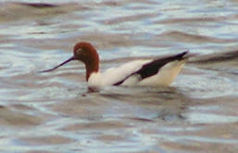Lake Bindegolly National Park
| Lake Bindegolly National Park | ||
|---|---|---|
| The lakes are an important refuge for the red-headed avocet ( Recurvirostra novaehollandiae ) | ||
|
|
||
| Location: | Queensland , Australia | |
| Specialty: | Salt and fresh water lakes, wetlands, birds | |
| Next city: | Thargomindah | |
| Surface: | 125 km² | |
| Founding: | 1994 | |
The Lake Bindegolly National Park (English: Lake Bindegolly National Park ) is a national park in the southwest of the Australian state of Queensland .
The park is located in the Mulga Lands ecoregion and was established to conserve a population of the rare Acacia ammophila .
location
It is located 871 kilometers west of Brisbane and 40 kilometers east of Thargomindah in the outback on Bulloo Developmental Road .
The national parks Currawinya and Binya are in the neighborhood .
National nature
There are three lakes in the park, Lake Bindegolly, Lake Toomaroo and Lake Hutchinson . Two of them are salt lakes, one is a freshwater lake. These lakes are surrounded by Southwest Queensland's main wetland, salt marshes and clay pans. Sand dunes run along the east bank of Lake Bindegolly, while stony plains stretch on the west bank, which further to the west build up to form a low mountain range, Mount Bindegolly .
Flora and fauna
The Acacia ammophila grows mainly along the sand dunes. The stony plain and the mountains on the west side of the park are overgrown with mulga . There is also sparse eucalyptus forest and bushland.
An area of 318 square kilometers of the lake and its surroundings has been classified by BirdLife International as an Important Bird Area (IBA) because more than one percent of the world population of Australian oar ducks and red-headed avocets ( Recurvirostra novaehollandiae ) live there. In addition, the park offers the following bird species habitat: inland Pluvialis ( Charadrius australis ), Bourke's Parrot , Slaty-backed Thornbill ( Acanthiza robustirostris ), gray crown honeyeater ( Lichenostomus keartlandi ), black honeyeater ( Sugomel nigrum ), Elster honeyeater ( Certhionyx variegatus ), Hall's Babbler ( Pomatostomus halli ), Chirruping Wedgebill ( Psophodes cristatus ) and Chestnut-breasted Quail-Trush ( Cinclosoma castaneothorax ).
Facilities and access
Camping and driving into the national park with vehicles and the lakes with boats are prohibited. There is a nine-kilometer hiking trail along Lake Bindegolly and through the sand dunes on the east bank.
The national park is directly north of the Bulloo Developmental Road, 40 kilometers east of Thargomindah and 150 kilometers west of Cunnamulla . Vehicles are to be parked on the roadside; the park may only be entered on foot.
Web links
- Official site of the park (English)
Individual evidence
- ↑ Australian Government - CAPAD 2010 ( MS Excel ; 170 kB), DSEWPaC , accessed on October 7, 2012 (English)
- ↑ Australian Government - CAPAD 1997 ( MS Excel ; 93 kB), DSEWPaC , accessed on October 7, 2012 (English)
- ^ SR Morton & J. Short & RD Barker: Refugia for Biological Diversity in Arid and Semi-arid Australia . Biodiversity Series, Paper No. 4. Department of the Environment, Water, Heritage and the Arts. Australian Government ( Memento of the original dated August 4, 2008 in the Internet Archive ) Info: The archive link was inserted automatically and has not yet been checked. Please check the original and archive link according to the instructions and then remove this notice.
- ^ A b Steve Parish: Australian Touring Atlas . Steve Parish Publishing. Archerfield QLD 2007. ISBN 978-1-74193-232-4 . P. 19
- ↑ a b c d Lake Bindegolly National Park . Department of Environment and Resource Management. Retrieved November 22, 2012
- ↑ IBA: Lake Bindegolly . In: Birdata . Birds Australia. Retrieved July 19, 2011.

